The Project Gutenberg eBook of Birds, Illustrated by Color Photography, Vol. 1, No. 3
most other parts of the world at no cost and with almost no restrictions
whatsoever. You may copy it, give it away or re-use it under the terms
of the Project Gutenberg License included with this ebook or online
at www.gutenberg.org. If you are not located in the United States,
you will have to check the laws of the country where you are located
before using this eBook.
Title: Birds, Illustrated by Color Photography, Vol. 1, No. 3
Author: Various
Release date: September 26, 2009 [eBook #30103]
Most recently updated: October 24, 2024
Language: English
Credits: Produced by Chris Curnow, Joseph Cooper and Anne Storer,
some images courtesy of The Internet Archive and the Online
Distributed Proofreading Team at https://www.pgdp.net
*** START OF THE PROJECT GUTENBERG EBOOK BIRDS, ILLUSTRATED BY COLOR PHOTOGRAPHY, VOL. 1, NO. 3 ***
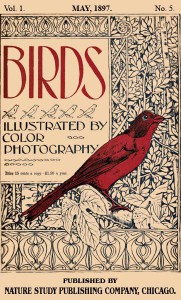
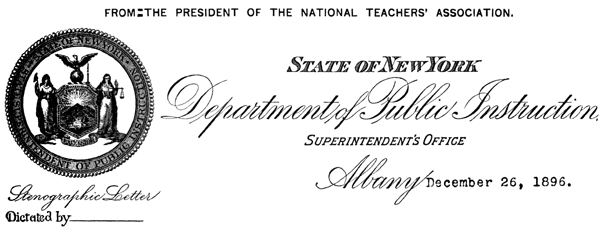
W. E. Watt, President &c.,
Fisher Building,
277 Dearborn St., Chicago, Ill.
My dear Sir:
Please accept my thanks for a copy of the first
publication of “Birds.” Please enter my name as a regular
subscriber. It is one of the most beautiful and interesting
publications yet attempted in this direction. It has other
attractions in addition to its beauty, and it must win its
way to popular favor.
Wishing the handsome little magazine abundant prosperity,
I remain
Yours very respectfully,


Please mention “BIRDS” when you write to advertisers.


[Pg 75]
LITTLE BOY BLUE.
Boys and girls, don’t you think
that is a pretty name? I came
from the warm south, where I
went last winter, to tell you that
Springtime is nearly here.
When I sing, the buds and
flowers and grass all begin to
whisper to one another, “Springtime
is coming for we heard the
Bluebird say so,” and then they
peep out to see the warm sunshine.
I perch beside them and
tell them of my long journey
from the south and how I knew
just when to tell them to come
out of their warm winter cradles.
I am of the same blue color as
the violet that shows her pretty
face when I sing, “Summer is
coming, and Springtime is here.”
I do not like the cities for
they are black and noisy and
full of those troublesome birds
called English Sparrows. I
take my pretty mate and out in
the beautiful country we find a
home. We build a nest of
twigs, grass and hair, in a box
that the farmer puts up for us
near his barn.
Sometimes we build in a hole
in some old tree and soon there
are tiny eggs in the nest. I
sing to my mate and to the good
people who own the barn. I
heard the farmer say one day,
“Isn’t it nice to hear the Bluebird
sing? He must be very
happy.” And I am, too, for by
this time there are four or five
little ones in the nest.
Little Bluebirds are like little
boys—they are always hungry.
We work hard to find enough
for them to eat. We feed them
nice fat worms and bugs, and
when their little wings are
strong enough, we teach them
how to fly. Soon they are large
enough to hunt their own food,
and can take care of themselves.
The summer passes, and when
we feel the breath of winter we
go south again, for we do not
like the cold.
THE BLUE BIRD.
I know the song that the Bluebird is singing
Out in the apple tree, where he is swinging.
Brave little fellow! the skies may be dreary,
Nothing cares he while his heart is so cheery.
Hark! how the music leaps out from his throat,
Hark! was there ever so merry a note?
Listen a while, and you’ll hear what he’s saying,
Up in the apple tree swinging and swaying.
“Dear little blossoms down under the snow,
You must be weary of winter, I know;
Hark! while I sing you a message of cheer,
Summer is coming, and springtime is here!”
“Dear little snow-drop! I pray you arise;
Bright yellow crocus! come open your eyes;
Sweet little violets, hid from the cold,
Put on our mantles of purple and gold;
Daffodils! daffodils! say, do you hear,
Summer is coming! and springtime is here!”
[Pg 76]
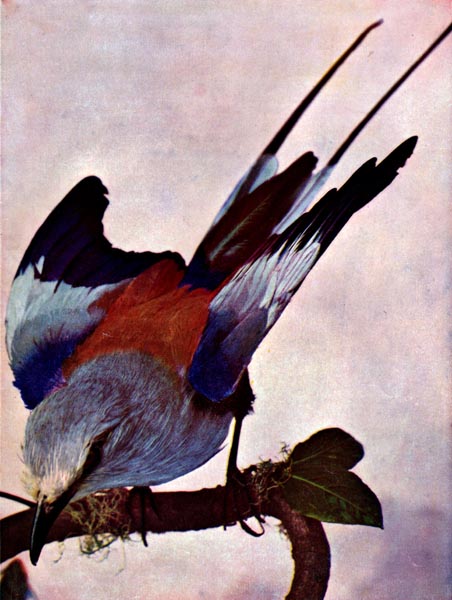
blue bird.
[Pg 78]
THE BLUE BIRD.
Winged lute that we call a blue bird,
You blend in a silver strain
The sound of the laughing waters,
The patter of spring’s sweet rain,
The voice of the wind, the sunshine,
And fragrance of blossoming things,
Ah! you are a poem of April
That God endowed with wings.E. E. R.

IKE a bit of sky this little
harbinger of spring appears,
as we see him and his mate
househunting in early
March. Oftentimes he
makes his appearance as early as the
middle of February, when his attractive
note is heard long before he himself
is seen. He is one of the last to
leave us, and although the month of
November is usually chosen by him as
the fitting time for departure to a
milder clime, his plaintive note is
quite commonly heard on pleasant
days throughout the winter season,
and a few of the braver and hardier
ones never entirely desert us. The
Robin and the Blue Bird are tenderly
associated in the memories of most
persons whose childhood was passed
on a farm or in the country village.
Before the advent of the English
Sparrow, the Blue Bird was sure to be
the first to occupy and the last to defend
the little box prepared for his return,
appearing in his blue jacket
somewhat in advance of the plainly
habited female, who on her arrival
quite often found a habitation selected
and ready for her acceptance, should
he find favor in her sight. And then
he becomes a most devoted husband
and father, sitting by the nest
and warbling with earnest affection
his exquisite tune, and occasionally flying
away in search of food for his mate
and nestlings.
The Blue Bird rears two broods in
the season, and, should the weather be
mild, even three. His nest contains
three eggs.
In the spring and summer when he
is happy and gay, his song is extremely
soft and agreeable, while it
grows very mournful and plaintive as
cold weather approaches. He is mild
of temper, and a peaceable and harmless
neighbor, setting a fine example
of amiability to his feathered friends.
In the early spring, however, he wages
war against robins, wrens, swallows,
and other birds whose habitations are
of a kind to take his fancy. A celebrated
naturalist says: “This bird
seems incapable of uttering a harsh
note, or of doing a spiteful, ill-tempered
thing.”
Nearly everybody has his anecdote
to tell of the Blue Bird’s courage, but
the author of “Wake Robin” tells
his exquisitely thus: “A few years
ago I put up a little bird house in the
back end of my garden for the accommodation
of the wrens, and every
season a pair have taken up their
abode there. One spring a pair of
Blue Birds looked into the tenement,
and lingered about several days, leading
me to hope that they would conclude
to occupy it. But they finally
went away. Late in the season the
wrens appeared, and after a little coquetting,
were regularly installed in
their old quarters, and were as happy
as only wrens can be. But before
their honeymoon was over, the Blue
Birds returned. I knew something
was wrong before I was up in the
morning. Instead of that voluble and
gushing song outside the window, I
heard the wrens scolding and crying
out at a fearful rate, and on going out
saw the Blue Birds in possession of
the box. The poor wrens were in
despair and were forced to look for
other quarters.”
[Pg 79]
THE SWALLOW.
“Come, summer visitant, attach
To my reedroof thy nest of clay,
And let my ear thy music catch,
Low twitting underneath the thatch,
At the gray dawn of day.”

URE harbingers of spring
are the Swallows. They
are very common birds,
and frequent, as a rule,
the cultivated lands in the
neighborhood of water, showing a decided
preference for the habitations of
man. “How gracefully the swallows
fly! See them coursing over the
daisy-bespangled grass fields; now
they skim just over the blades of grass,
and then with a rapid stroke of their
long wings mount into the air and
come hovering above your head, displaying
their rich white and chestnut
plumage to perfection. Now they
chase each other for very joyfulness,
uttering their sharp twittering notes;
then they hover with expanded wings
like miniature Kestrels, or dart downwards
with the velocity of the sparrowhawk;
anon they flit rapidly over
the neighboring pool, occasionally
dipping themselves in its calm and
placid waters, and leaving a long train
of rings marking their varied course.
How easily they turn, or glide over
the surrounding hedges, never resting,
never weary, and defying the eye to
trace them in the infinite turnings and
twistings of their rapid shooting flight.
You frequently see them glide rapidly
near the ground, and then with a sidelong
motion mount aloft, to dart
downwards like an animated meteor,
their plumage glowing in the light
with metallic splendor, and the row of
white spots on the tail contrasting
beautifully with the darker plumage.”
The Swallow is considered a life-paired
species, and returns to its nesting
site of the previous season, building
a new nest close to the old one.
His nest is found in barns and outhouses,
upon the beams of wood
which support the roof, or in any
place which assures protection to the
young birds. It is cup-shaped and
artfully moulded of bits of mud.
Grass and feathers are used for the
lining. “The nest completed, five or
six eggs are deposited. They are of a
pure white color, with deep rich
brown blotches and spots, notably at
the larger end, round which they
often form a zone or belt.” The sitting
bird is fed by her mate.
The young Swallow is distinguished
from the mature birds by the
absence of the elongated tail feathers,
which are a mark of maturity alone.
His food is composed entirely of insects.
Swallows are on the wing fully
sixteen hours, and the greater part of
the time making terrible havoc
amongst the millions of insects which
infest the air. It is said that when
the Swallow is seen flying high in the
heavens, it is a never failing indication
of fine weather.
A pair of Swallows on arriving at
their nesting place of the preceding
Summer found their nest occupied by
a Sparrow, who kept the poor birds at
a distance by pecking at them with
his strong beak whenever they attempted
to dislodge him. Wearied
and hopeless of regaining possession
of their property, they at last hit upon
a plan which effectually punished the
intruder. One morning they appeared
with a few more Swallows—their
mouths filled with a supply of tempered
clay—and, by their joint efforts
in a short time actually plastered up
the entrance to the hole, thus barring
the Sparrow from the home which he
had stolen from the Swallows.
[Pg 80]
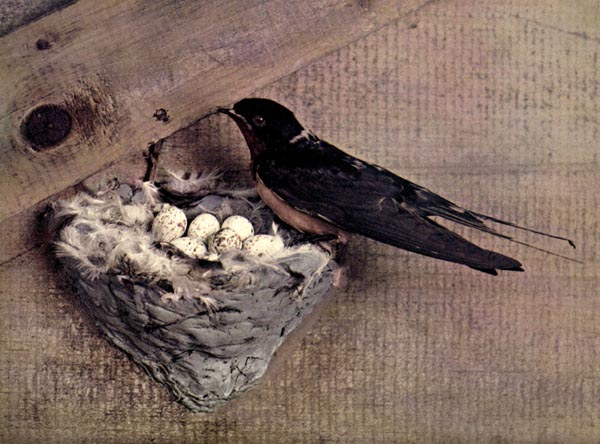
barn swallow.
[Pg 82]
THE BROWN THRUSH.
“However the world goes ill,
The Thrushes still sing in it.”

HE Mocking-bird of the North,
as the Brown Thrush has
been called, arrives in the
Eastern and Middle States
about the 10th of May, at which
season he may be seen, perched on the
highest twig of a hedge, or on the
topmost branch of a tree, singing his
loud and welcome song, that may be
heard a distance of half a mile. The
favorite haunt of the Brown Thrush,
however, is amongst the bright and
glossy foliage of the evergreens.
“There they delight to hide, although
not so shy and retiring as the Blackbird;
there they build their nests in
greatest numbers, amongst the perennial
foliage, and there they draw at
nightfall to repose in warmth and
safety.” The Brown Thrasher sings
chiefly just after sunrise and before
sunset, but may be heard singing at
intervals during the day. His food
consists of wild fruits, such as blackberries
and raspberries, snails, worms,
slugs and grubs. He also obtains
much of his food amongst the withered
leaves and marshy places of the
woods and shrubberies which he
frequents. Few birds possess a more
varied melody. His notes are almost
endless in variety, each note seemingly
uttered at the caprice of the bird,
without any perceptible approach to
order.
The site of the Thrush’s nest is a
varied one, in the hedgerows, under a
fallen tree or fence-rail; far up in the
branches of stately trees, or amongst
the ivy growing up their trunks. The
nest is composed of the small dead
twigs of trees, lined with the fine
fibers of roots. From three to five
eggs are deposited, and are hatched
in about twelve days. They have a
greenish background, thickly spotted
with light brown, giving the whole
egg a brownish appearance.
The Brown Thrush leaves the Eastern
and Middle States, on his migration
South, late in September, remaining
until the following May.
[Pg 83]
THE THRUSH’S NEST.
“Within a thick and spreading hawthorn bush
That overhung a molehill, large and round,
I heard from morn to morn a merry thrush
Sing hymns of rapture while I drank the sound
With joy—and oft an unintruding guest,
I watched her secret toils from day to day;
How true she warped the moss to form her nest,
And modeled it within with wood and clay.
And by and by, with heath-bells gilt with dew,
There lay her shining eggs as bright as flowers,
Ink-spotted over, shells of green and blue:
And there I witnessed, in the summer hours,
A brood of nature’s minstrels chirp and fly,
Glad as the sunshine and the laughing sky.”
THE BROWN THRUSH.
Dear Readers:
My cousin Robin Redbreast
told me that he wrote you a
letter last month and sent it
with his picture. How did you
like it? He is a pretty bird—Cousin
Robin—and everybody
likes him. But I must tell you
something of myself.
Folks call me by different
names—some of them nicknames,
too.
The cutest one of all is Brown
Thrasher. I wonder if you
know why they call me Thrasher.
If you don’t, ask some one. It
is really funny.
Some people think Cousin
Robin is the sweetest singer of
our family, but a great many
like my song just as well.
Early in the morning I sing
among the bushes, but later in
the day you will always find me
in the very top of a tree and it
is then I sing my best.
Do you know what I say in
my song? Well, if I am near a
farmer while he is planting, I
say: “Drop it, drop it—cover it
up, cover it up—pull it up, pull
it up, pull it up.”
One thing I very seldom do
and that is, sing when near my
nest. Maybe you can tell why.
I’m not very far from my nest
now. I just came down to the
stream to get a drink and am
watching that boy on the other
side of the stream. Do you see
him?
One dear lady who loves birds
has said some very nice things
about me in a book called “Bird
Ways.” Another lady has
written a beautiful poem about
my singing. Ask your mamma or
teacher the names of these
ladies. Here is the poem:
There’s a merry brown thrush sitting up in a tree.
He is singing to me! He is singing to me!
And what does he say—little girl, little boy?
“Oh, the world’s running over with joy!
Hush! Look! In my tree,
I am as happy as happy can be.”
And the brown thrush keeps singing, “A nest, do you see,
And five eggs, hid by me in the big cherry tree?
Don’t meddle, don’t touch—little girl, little boy—
Or the world will lose some of its joy!
Now I am glad! now I am free!
And I always shall be,
If you never bring sorrow to me.”
So the merry brown thrush sings away in the tree
To you and to me—to you and to me;
And he sings all the day—little girl, little boy—
“Oh, the world’s running over with joy!
But long it won’t be,
Don’t you know? don’t you see?
Unless we’re good as good can be.”
[Pg 84]
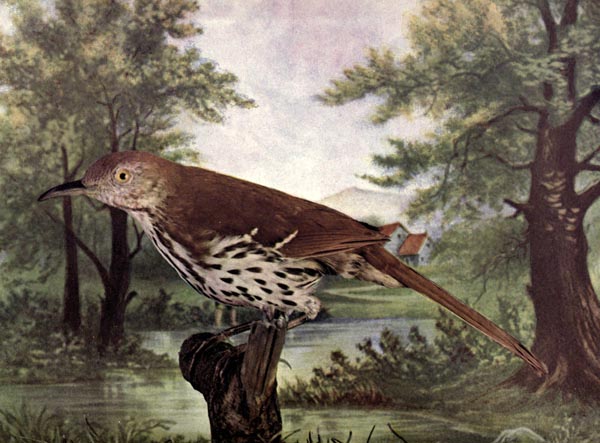
brown thrasher.
[Pg 86]
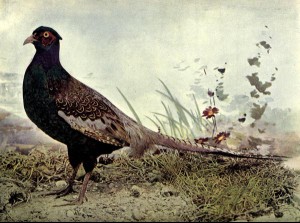
japan pheasant.
[Pg 88]
THE JAPAN PHEASANT.

RIGINALLY the Pheasant
was an inhabitant of Asia
Minor but has been by degrees
introduced into many
countries, where its beauty
of form, plumage, and the delicacy of
its flesh made it a welcome visitor.
The Japan Pheasant is a very beautiful
species, about which little is
known in its wild state, but in captivity
it is pugnacious. It requires
much shelter and plenty of food, and
the breed is to some degree artificially
kept up by the hatching of eggs under
domestic hens and feeding them
in the coop like ordinary chickens,
until they are old and strong enough
to get their own living.
The food of this bird is extremely
varied. When young it is generally
fed on ants’ eggs, maggots,
grits, and similar food, but when it is
full grown it is possessed of an accommodating
appetite and will eat many
kinds of seeds, roots, and leaves. It
will also eat beans, peas, acorns, berries,
and has even been known to eat
the ivy leaf, as well as the berry.
This Pheasant loves the ground,
runs with great speed, and always prefers
to trust to its legs rather than to its
wings. It is crafty, and when alarmed
it slips quickly out of sight behind a
bush or through a hedge, and then
runs away with astonishing rapidity,
always remaining under cover until it
reaches some spot where it deems itself
safe. The male is not domestic,
passing an independent life during
a part of the year and associating
with others of its own sex during the
rest of the season.
The nest is very rude, being merely
a heap of leaves and grass on the
ground, with a very slight depression.
The eggs are numerous, about eleven
or twelve, and olive brown in color. In
total length, though they vary considerably,
the full grown male is about
three feet. The female is smaller in
size than her mate, and her length
a foot less.
The Japan Pheasant is not a particularly
interesting bird aside from his
beauty, which is indeed brilliant, there
being few of the species more attractive.
[Pg 89]
THE FLICKER.

GREAT variety of names
does this bird possess. It
is commonly known as the
Golden Winged Woodpecker,
Yellow-shafted Flicker, Yellow
Hammer, and less often as High-hole
or High-holer, Wake-up, etc. In suitable
localities throughout the United
States and the southern parts of Canada,
the Flicker is a very common
bird, and few species are more generally
known. “It is one of the most
sociable of our Woodpeckers, and is
apparently always on good terms with
its neighbors. It usually arrives in
April, occasionally even in March, the
males preceding the females a few
days, and as soon as the latter appear
one can hear their voices in all directions.”
The Flicker is an ardent wooer. It
is an exceedingly interesting and
amusing sight to see a couple of males
paying their addresses to a coy and
coquettish female; the apparent shyness
of the suitors as they sidle up to
her and as quickly retreat again, the
shy glances given as one peeps from
behind a limb watching the other—playing
bo-peep—seem very human,
and “I have seen,” says an observer,
“few more amusing performances than
the courtship of a pair of these birds.”
The defeated suitor takes his rejection
quite philosophically, and retreats in a
dignified manner, probably to make
other trials elsewhere. Few birds
deserve our good will more than the
Flicker. He is exceedingly useful,
destroying multitudes of grubs, larvæ,
and worms. He loves berries and
fruit but the damage he does to cultivated
fruit is very trifling.
The Flicker begins to build its nest
about two weeks after the bird arrives
from the south. It prefers open country,
interspersed with groves and orchards,
to nest in. Any old stump, or
partly decayed limb of a tree, along
the banks of a creek, beside a country
road, or in an old orchard, will answer
the purpose. Soft wood trees seem to
be preferred, however. In the prairie
states it occasionally selects strange
nesting sites. It has been known to
chisel through the weather boarding of
a dwelling house, barns, and other buildings,
and to nest in the hollow space
between this and the cross beams; its
nests have also been found in gate
posts, in church towers, and in burrows
of Kingfishers and bank swallows, in
perpendicular banks of streams. One
of the most peculiar sites of his selection
is described by William A. Bryant
as follows: “On a small hill, a
quarter of a mile distant from any
home, stood a hay stack which had
been placed there two years previously.
The owner, during the winter of
1889-90, had cut the stack through the
middle and hauled away one portion,
leaving the other standing, with the
end smoothly trimmed. The following
spring I noticed a pair of flickers about
the stack showing signs of wanting to
make it a fixed habitation. One morning
a few days later I was amused at
the efforts of one of the pair. It was
clinging to the perpendicular end of
the stack and throwing out clipped
hay at a rate to defy competition.
This work continued for a week, and
in that time the pair had excavated a
cavity twenty inches in depth. They
remained in the vicinity until autumn.
During the winter the remainder of
the stack was removed. They returned
the following spring, and, after
a brief sojourn, departed for parts unknown.”
From five to nine eggs are generally
laid. They are glossy white in color,
and when fresh appear as if enameled.
The young are able to leave the
nest in about sixteen days; they crawl
about on the limbs of the tree for a
couple of days before they venture to
fly, and return to the nest at night.
[Pg 90]
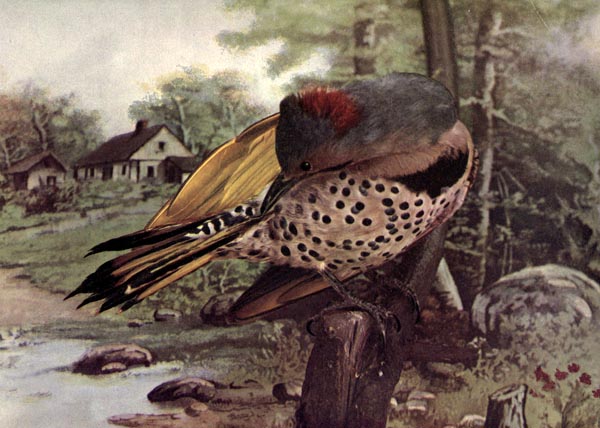
flicker.
[Pg 92]
THE BOBOLINK.
“When Nature had made all her birds,
And had no cares to think on,
She gave a rippling laugh,
And out there flew a Bobolinkon.”

O American ornithologist
omits mention of the Bobolink,
and naturalists generally
have described
him under one of the
many names by which he is known.
In some States he is called the Rice
Bird, in others Reed Bird, the Rice or
Reed Bunting, while his more familiar
title, throughout the greater part of
America, is Bobolink, or Bobolinkum.
In Jamaica, where he gets very fat
during his winter stay, he is called the
Butter Bird. His title of Rice
Troopial is earned by the depredations
which he annually makes upon the
rice crops, though his food “is by no
means restricted to that seed, but consists
in a large degree of insects, grubs,
and various wild grasses.” A migratory
bird, residing during the winter
in the southern parts of America, he
returns in vast multitudes northward
in the early Spring. According to
Wilson, their course of migration is as
follows: “In April, or very early in
May, the Rice Buntings, male and
female, arrive within the southern
boundaries of the United States, and
are seen around the town of Savannah,
Georgia, sometimes in separate
parties of males and females, but
more generally promiscuously. They
remain there but a short time, and
about the middle of May make their
appearance in the lower part of
Pennsylvania. While here the males
are extremely gay and full of song,
frequenting meadows, newly plowed
fields, sides of creeks, rivers, and
watery places, feeding on May flies
and caterpillars, of which they destroy
great quantities. In their passage,
however, through Virginia at this season,
they do great damage to the early
wheat and barley while in their milky
state. About the 20th of May they
disappear on their way to the North.
Nearly at the same time they arrive in
the State of New York, spread over
the whole of the New England
States, as far as the river St. Lawrence,
and from Lake Ontario to the
sea. In all of these places they remain
during the Summer, building
their nests and rearing their young.”
The Bobolink’s song is a peculiar
one, varying greatly with the occasion.
As he flys southward, his cry is
a kind of clinking note; but the love
song addressed to his mate is voluble
and fervent. It has been said that if
you should strike the keys of a pianoforte
haphazard, the higher and the
lower singly very quickly, you might
have some idea of the Bobolink’s
notes. In the month of June he
gradually changes his pretty, attractive
dress and puts on one very like
the females, which is of a plain rusty
brown, and is not reassumed until the
next season of nesting. The two parent
birds in the plate represent the
change from the dark plumage in
which the bird is commonly known
in the North as the Bobolink, to the
dress of yellowish brown by which it
is known throughout the South as the
Rice or Reed Bird.
His nest, small and a plain one, too,
is built on the ground by his industrious
little wife. The inside is warmly
lined with soft fibers of whatever may
be nearest at hand. Five pretty white
eggs, spotted all over with brown are
laid, and as soon
“As the little ones chip the shell
And five wide mouths are ready for food,
‘Robert of Lincoln’ bestirs him well,
Gathering seeds for this hungry brood.”
[Pg 93]
BOBOLINK.
Other birds may like to travel
alone, but when jolly Mr. Bobolink
and his quiet little wife
come from the South, where they
have spent the winter, they
come with a large party of
friends. When South, they eat
so much rice that the people call
them Rice Birds. When they
come North, they enjoy eating
wheat, barley, oats and insects.
Mr. and Mrs. Bobolink build
their simple little nest of grasses
in some field. It is hard to find
on the ground, for it looks just
like dry grass. Mrs. Bobolink
wears a dull dress, so she cannot
be seen when she is sitting on
the precious eggs. She does
not sing a note while caring
for the eggs. Why do you
think that is?
Mr. Bob-Linkum does not
wear a sober dress, as you can
see by his picture. He does not
need to be hidden. He is just
as jolly as he looks. Shall I
tell you how he amuses his mate
while she is sitting? He springs
from the dew-wet grass with a
sound like peals of merry laughter.
He frolics from reed to
post, singing as if his little
heart would burst with joy.
Don’t you think Mr. and Mrs.
Bobolink look happy in the
picture? They have raised
their family of five. Four of
their children have gone to look
for food; one of them—he must
surely be the baby—would
rather stay with his mamma and
papa. Which one does he look
like?
Many birds are quiet at noon
and in the afternoon. A flock
of Bobolinks can be heard singing
almost all day long. The
song is full of high notes and
low, soft notes and loud, all
sung rapidly. It is as gay and
bright as the birds themselves,
who flit about playfully as they
sing. You will feel like laughing
as merrily as they sing when
you hear it some day.
[Pg 94]
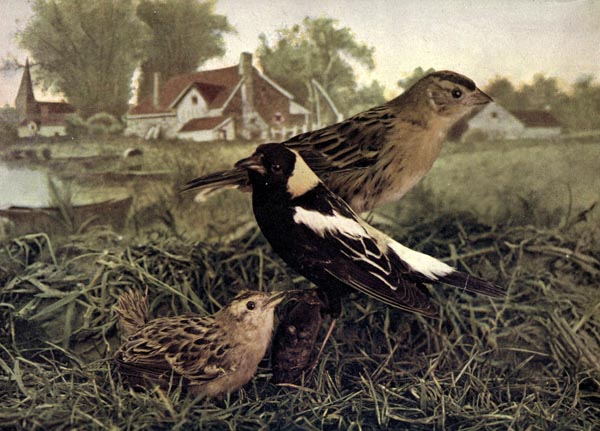
bobolinks.
[Pg 96]
THE BLUE BIRD.
“Drifting down the first warm wind
That thrills the earliest days of spring,
The Bluebird seeks our maple groves
And charms them into tasselling.”
“He sings, and his is Nature’s voice—
A gush of melody sincere
From that great fount of harmony
Which thaws and runs when Spring is here.”
“Short is his song, but strangely sweet
To ears aweary of the low
Dull tramps of Winter’s sullen feet,
Sandalled in ice and muffled in snow.”
“Think, every morning, when the sun peeps through
The dim, leaf-latticed windows of the grove,
How jubilant the happy birds renew
Their old, melodious madrigals of love!
And when you think of this, remember, too,
’Tis always morning somewhere, and above
The awakening continents, from shore to shore,
Somewhere the birds are singing evermore.
“Think of your woods and orchards without birds!
Of empty nests that cling to boughs and beams
As in an idiot’s brain remembered words
Hang empty ’mid the cobwebs of his dreams!
Will bleat of flocks or bellowing of herds
Make up for the lost music, when your teams
Drag home the stingy harvest, and no more
The feathered gleaners follow to your door?”
From “The Birds of Killingsworth.”
[Pg 97]
THE CROW.
Caw! Caw! Caw! little boys
and girls. Caw! Caw! Caw!
Just look at my coat of feathers.
See how black and glossy it is.
Do you wonder I am proud of it?
Perhaps you think I look very
solemn and wise, and not at all
as if I cared to play games. I
do, though; and one of the
games I like best is hide-and-seek.
I play it with the farmer
in the spring. He hides, in the
rich, brown earth, golden kernels
of corn. Surely he does it because
he knows I like it, for
sometimes he puts up a stick all
dressed like a man to show
where the corn is hidden. Sometimes
I push my bill down into
the earth to find the corn, and at
other times I wait until tiny
green leaves begin to show above
the ground, and then I get my
breakfast without much trouble.
I wonder if the farmer enjoys
this game as much as I do. I
help him, too, by eating worms
and insects.
During the spring and summer
I live in my nest on the top
of a very high tree. It is built
of sticks and grasses and straw
and string and anything else I
can pick up. But in the fall, I
and all my relations and friends
live together in great roosts or
rookeries. What good times
we do have—hunting all day
for food and talking all night.
Wouldn’t you like to be with us?
The farmer who lives in the
house over there went to the mill
to-day with a load of corn.
One of the ears dropped out
of the wagon and it didn’t take
me long to find it. I have eaten
all I can possibly hold and am
wondering now what is the best
thing to do. If you were in my
place would you leave it here
and not tell anybody and come
back to-morrow and finish it? Or
would you fly off and get Mrs.
Crow and some of the children
to come and finish it? I believe
I’ll fly and get them. Good-bye.
Caw! Caw! Caw!
[Pg 98]
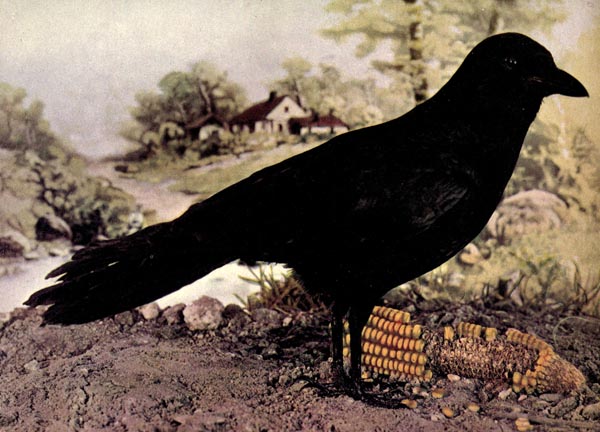
common crow.
[Pg 100]
THE COMMON CROW.
“The crow doth sing as merry as the lark,
When neither is attended.”

EW birds have more interesting
characteristics than the Common
Crow, being, in many of
his actions, very like the
Raven, especially in his love for
carrion. Like the Raven, he has been
known to attack game, although his
inferior size forces him to call to his
assistance the aid of his fellows to cope
with larger creatures. Rabbits and
hares are frequently the prey of this
bird which pounces on them as
they steal abroad to feed. His
food consists of reptiles, frogs, and
lizards; he is a plunderer of other
birds’ nests. On the seashore he finds
crabs, shrimps and inhabited shells,
which he ingeniously cracks by flying
with them to a great height and
letting them fall upon a convenient
rock.
The crow is seen in single pairs or
in little bands of four or five. In the
autumn evenings, however, they
assemble in considerable flocks before
going to roost and make a wonderful
chattering, as if comparing notes of
the events of the day.
The nest of the Crow is placed in
some tree remote from habitations of
other birds. Although large and
very conspicuous at a distance, it is
fixed upon one of the topmost branches
quite out of reach of the hand of the
adventurous urchin who longs to
secure its contents. It is loosely made
and saucer shaped. Sticks and softer
substances are used to construct it,
and it is lined with hair and fibrous
roots. Very recently a thrifty and
intelligent Crow built for itself a
summer residence in an airy tree near
Bombay, the material used being gold,
silver, and steel spectacle frames,
which the bird had stolen from an
optician of that city. Eighty-four
frames had been used for this purpose,
and they were so ingeniously woven
together that the nest was quite a
work of art. The eggs are variable,
or rather individual, in their markings,
and even in their size. The Crow
rarely uses the same nest twice,
although he frequently repairs to the
same locality from year to year. He
is remarkable for his attachment to
his mate and young, surpassing the
Fawn and Turtle Dove in conjugal
courtesy.
The Somali Arabs bear a deadly
hatred toward the Crow. The origin
of their detestation is the superstition
that during the flight of Mohammed
from his enemies, he hid himself in a
cave, where he was perceived by the
Crow, at that time a bird of light
plumage, who, when he saw the pursuers
approaching the spot, perched
above Mohammed’s hiding place, and
screamed, “Ghar! Ghar!” (cave! cave!)
so as to indicate the place of concealment.
His enemies, however, did not
understand the bird, and passed on,
and Mohammed, when he came out of
the cave, clothed the Crow in perpetual
black, and commanded him to
cry “Ghar” as long as Crows should
live.
And he lives to a good old age.
Instances are not rare where he has
attained to half a century, without
great loss of activity or failure of sight.
At Red Bank, a few miles northeast
of Cincinnati, on the Little Miami
River, in the bottoms, large flocks of
Crows congregate the year around. A
few miles away, high upon Walnut
Hills, is a Crow roost, and in the
late afternoons the Crows, singly, in
pairs, and in flocks, are seen on the
wing, flying heavily, with full crops,
on the way to the roost, from which
they descend in the early morning,
crying “Caw! Caw!” to the fields of
the newly planted, growing, or
matured corn, or corn stacks, as the
season may provide.
[Pg 101]
THE RETURN OF THE BIRDS.
“Everywhere the blue sky belongs to them and is their appointed rest,
and their native country, and their own natural home which they enter
unannounced as lords that are certainly expected, and yet there is a
silent joy at their arrival.”

HE return of the birds to their
real home in the North, where
they build their nests and
rear their young, is regarded
by all genuine lovers of earth’s messengers
of gladness and gayety as one
of the most interesting and poetical of
annual occurrences. The naturalist,
who notes the very day of each arrival,
in order that he may verify former
observation or add to his material
gathered for a new work, does not
necessarily anticipate with greater
pleasure this event than do many
whose lives are brightened by the
coming of the friends of their youth,
who alone of early companions do not
change. First of all—and ever the
same delightful warbler—the Bluebird,
who, in 1895, did not appear at
all in many localities, though here in
considerable numbers last year, betrays
himself. “Did he come down out
of the heaven on that bright March
morning when he told us so softly and
plaintively that, if we pleased, spring
had come?” Sometimes he is here
a little earlier, and must keep his
courage up until the cold snap is over
and the snow is gone. Not long after
the Bluebird, comes the Robin, sometimes
in March, but in most of the
northern states April is the month of
his arrival. With his first utterance
the spell of winter is broken, and the
remembrance of it afar off. Then
appears the Woodpecker in great
variety, the Flicker usually arriving
first. He is always somebody’s old
favorite, “announcing his arrival by a
long, loud call, repeated from the dry
branch of some tree, or a stake in the
fence—a thoroughly melodious April
sound.”
Few perhaps reflect upon the difficulties
encountered by the birds themselves
in their returning migrations.
A voyager sometimes meets with
many of our common birds far out at
sea. Such wanderers, it is said, when
suddenly overtaken by a fog, completely
lose their sense of direction
and become hopelessly lost. Humming
birds, those delicately organized,
glittering gems, are among the most
common of the land species seen at sea.
The present season has been quite
favorable to the protection of birds.
A very competent observer says that
not all of the birds migrated this
winter. He recently visited a farm
less than an hour’s ride from Chicago,
where he found the old place, as he
relates it, “chucked full of Robins,
Blackbirds, and Woodpeckers,” and
others unknown to him. From this
he inferred they would have been in
Florida had indications predicted a
severe winter. The trees of the south
parks of Chicago, and those in
suburban places, have had, darting
through their branches during the
months of December and January,
nearly as many members of the Woodpecker
tribe as were found there
during the mating season in May last.
Alas, that the Robin will visit us in
diminished numbers in the approaching
spring. He has not been so common
for a year or two as he was
formerly, for the reason that the
Robins died by thousands of starvation,
owing to the freezing of their food
supply in Tennessee during the protracted
cold weather in the winter of
1895. It is indeed sad that this good
Samaritan among birds should be
defenseless against the severity of
Nature, the common mother of us all.
Nevertheless the return of the birds,
in myriads or in single pairs, will
be welcomed more and more, year by
year, as intelligent love and appreciation
of them shall possess the popular
mind.
[Pg 103]

black tern.
Mother and Young with Eggs.
[Pg 104]
THE BLACK TERN.

HE TERN,” says Mr. F. M.
Woodruff, of the Chicago
Academy of Sciences, “is
the only representative of
the long-winged swimmers which
commonly nests with us on our
inland fresh water marshes, arriving
early in May in its brooding plumage
of sooty black. The color changes
in the autumn to white, and a number
of the adult birds may be found, in
the latter part of July, dotted and
streaked here and there with white.
On the first of June, 1891, I found a
large colony of Black Terns nesting
on Hyde Lake, Cook County, Illinois.
As I approached the marsh a few
birds were seen flying high in the air,
and, as I neared the nesting site, the
flying birds gave notes of alarm, and
presently the air was filled with the
graceful forms of this beautiful little
bird. They circled about me, darting
down to within a few feet of my head,
constantly uttering a harsh, screaming
cry. As the eggs are laid upon the
bare ground, which the brownish and
blackish markings so closely resemble,
I was at first unable to find the nests,
and discovered that the only way to
locate them was to stand quietly and
watch the birds. When the Tern is
passing over the nest it checks its
flight, and poises for a moment on
quivering wings. By keeping my
eyes on this spot I found the nest
with very little trouble. The complement
of eggs, when the bird has not
been disturbed, is usually three.
These are laid in a saucer shaped
structure of dead vegetation, which is
scraped together, from the surface of
the wet, boggy ground. The bird
figured in the plate had placed its
nest on the edge of an old muskrat
house, and my attention was attracted
to it by the fact that upon the edge of
the rat house, where it had climbed to
rest itself, was the body of a young
dabchick, or piedbilled grebe, scarcely
two and one-half inches long, and not
twenty-four hours out of the egg, a
beautiful little ball of blackish down,
striped with brown and white. From
the latter part of July to the middle of
August large flocks of Black Terns
may be seen on the shores of our
larger lakes on their annual migration
southward.”
The Rev. P. B. Peabody, in alluding to
his observation of the nests of the
Tern, says: “Amid this floating sea
of aquatic nests I saw an unusual
number of well constructed homes of
the Tern. Among these was one that
I count a perfect nest. It rested on
the perfectly flat foundation of a small
decayed rat house, which was about
fourteen inches in diameter. The nest,
in form, is a truncated cone (barring the
cavity), was about eight inches high
and ten inches in diameter. The
hollow—quite shallow—was about
seven inches across, being thus unusually
large. The whole was built
up of bits of rushes, carried to the spot,
these being quite uniform in length—about
four inches.” After daily
observation of the Tern, during which
time he added much to his knowledge
of the bird, he pertinently asks: “Who
shall say how many traits and habits
yet unknown may be discovered
through patient watching of community-breeding
birds, by men enjoying
more of leisure for such delightful
studies than often falls to the lot of
most of us who have bread and butter
to earn and a tiny part of the world’s
work to finish?”
[Pg 105]
THE MEADOW LARK.
“Not an inch of his body is free from delight.
Can he keep himself still if he would? Oh, not he!
The music stirs in him like wind through a tree.”

HE well known Meadow or
Old Field Lark is a constant
resident south of latitude
39, and many winter
farther north in favorite localities.
Its geographical range is eastern
North America, Canada to south Nova
Scotia, Quebec, and Ontario to eastern
Manitoba; west to Minnesota, Iowa,
Missouri, eastern Kansas, the Indian
Territory, and Texas; south to Florida
and the Gulf coast, in all of which
localities, except in the extreme north,
it usually rears two or three broods in
a season. In the Northern States it
is only a summer resident, arriving in
April and remaining until the latter
part of October and occasionally
November. Excepting during the
breeding season, small flocks may
often be seen roving about in search
of good feeding grounds. Major Bendire
says this is especially true in the
fall of the year. At this time several
families unite, and as many as two
dozen may occasionally be flushed in
a field, over which they scatter, roaming
about independently of each other.
When one takes wing all the others
in the vicinity follow. It is a shy
bird in the East, while in the middle
states it is quite the reverse. Its flight
is rather laborious, at least in starting,
and is continued by a series of rapid
movements of the wings, alternating
with short distances of sailing, and is
rarely protracted. On alighting, which
is accompanied with a twitching of its
tail, it usually settles on some fence
rail, post, boulder, weedstock, or on
a hillock in a meadow from which it
can get a good view of the surroundings,
and but rarely on a limb of a
tree. Its favorite resorts are meadows,
fallow fields, pastures, and clearings,
but in some sections, as in northern
Florida, for instance, it also frequents the
low, open pine woods and nests there.
The song of the Meadow Lark is
not much varied, but its clear, whistling
notes, so frequently heard in the
early spring, are melodious and pleasing
to the ear. It is decidedly the
farmers’ friend, feeding, as it does, on
noxious insects, caterpillars, moths,
grasshoppers, spiders, worms and the
like, and eating but little grain. The
lark spends the greater part of its
time on the ground, procuring all its
food there. It is seldom found alone,
and it is said remains paired for life.
Nesting begins in the early part of
May and lasts through June. Both
sexes assist in building the nest, which
is always placed on the ground, either
in a natural depression, or in a little
hollow scratched out by the birds,
alongside a bunch of grass or weeds.
The nest itself is lined with dry grass,
stubble, and sometimes pine needles.
Most nests are placed in level meadows.
The eggs and young are frequently
destroyed by vermin, for the meadow
lark has many enemies. The eggs
vary from three to seven, five being
the most common, and both sexes assist
in the hatching, which requires
about fifteen or sixteen days. The
young leave the nest before they are
able to fly—hiding at the slightest
sign of danger. The Meadow Lark
does not migrate beyond the United
States. It is a native bird, and is only
accidental in England. The eggs
are spotted, blotched, and speckled
with shades of brown, purple and
lavender. A curious incident is told
of a Meadow Lark trying to alight on
the top mast of a schooner several
miles at sea. It was evidently very tired
but would not venture near the deck.
[Pg 106]
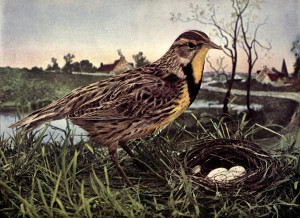
meadow lark.
[Pg 108]
THE MEADOW LARK.
I told the man who wanted
my picture that he could take it
if he would show my nest and
eggs. Do you blame me for
saying so? Don’t you think it
makes a better picture than if I
stood alone?
Mr. Lark is away getting me
some breakfast, or he could be
in the picture, too. After a few
days I shall have some little
baby birds, and then won’t we
be happy.
Boys and girls who live in the
country know us pretty well.
When they drive the cows out
to pasture, or when they go out
to gather wild flowers, we sit on
the fences by the roadside and
make them glad with our merry
song.
Those of you who live in the
city cannot see us unless you
come out into the country.
It isn’t very often that we can
find such a pretty place for a
nest as we have here. Most of
the time we build our nest under
the grass and cover it over, and
build a little tunnel leading to
it. This year we made up our
minds not to be afraid.
The people living in the houses
over there do not bother us at all
and we are so happy.
You never saw baby larks,
did you? Well, they are queer
little fellows, with hardly any
feathers on them.
Last summer we had five little
birdies to feed, and it kept us
busy from morning till night.
This year we only expect three,
and Mr. Lark says he will do all
the work. He knows a field
that is being plowed, where he
can get nice, large worms.
Hark! that is he singing.
He will be surprised when he
comes back and finds me off the
nest. He is so afraid that I will
let the eggs get cold, but I
won’t. There he comes, now.
[Pg 109]
THE LONG-EARED OWL.

HE name of the Long-Eared
Owl is derived from the great
length of his “ears” or feather-tufts,
which are placed upon
the head, and erect themselves whenever
the bird is interested or excited.
It is the “black sheep” of the owl
family, the majority of owls being
genuine friends of the agriculturist,
catching for his larder so many of
the small animals that prey upon
his crops. In America he is called
the Great Horned Owl—in Europe
the Golden Owl.
Nesting time with the owl begins
in February, and continues through
March and April. The clown-like
antics of both sexes of this bird while
under the tender influence of the
nesting season tend somewhat to impair
their reputation for dignity and
wise demeanor. They usually have a
simple nest in a hollow tree, but
which seems seldom to be built by the
bird itself, as it prefers to take the
deserted nest of some other bird, and
to fit up the premises for its own use.
They repair slightly from year to year
the same nest. The eggs are white,
and generally four or five in number.
While the young are still in the nest,
the parent birds display a singular
diligence in collecting food for them.
If you should happen to know of an
owl’s nest, stand near it some evening
when the old birds are rearing their
young. Keep quiet and motionless,
and notice how frequently the old
birds feed them. Every ten minutes
or so the soft flap, flap of their wings
will be heard, the male and female
alternately, and you will obtain a brief
glimpse of them through the gloom as
they enter the nesting place. They
remain inside but a short time, sharing
the food equally amongst their brood,
and then are off again to hunt for
more. All night, were you to have
the inclination to observe them, you
would find they pass to and fro with
food, only ceasing their labors at dawn.
The young, as soon as they reach
maturity, are abandoned by their
parents; they quit the nest and seek
out haunts elsewhere, while the old
birds rear another, and not infrequently
two more broods, during the remainder
of the season.
The habits of the Long-Eared Owl
are nocturnal. He is seldom seen
in the light of day, and is greatly disturbed
if he chance to issue from
his concealment while the sun is
above the horizon. The facial disk is
very conspicuous in this species. It is
said that the use of this circle is to
collect the rays of light, and throw
them upon the eye. The flight of the
owl is softened by means of especially
shaped, recurved feather-tips, so that
he may noiselessly steal upon his
prey, and the ear is also so shaped as
to gather sounds from below.
The Long-Eared Owl is hardly
tameable. The writer of this paragraph,
when a boy, was the possessor,
for more than a year, of a very fine
specimen. We called him Judge. He
was a monster, and of perfect plumage.
Although he seemed to have some
attachment to the children of the
family who fed him, he would not
permit himself to be handled by them
or by any one in the slightest. Most
of his time he spent in his cage, an
immense affair, in which he was very
comfortable. Occasionally he had
a day in the barn with the rats and
mice.
The owl is of great usefulness to
gardener, agriculturist, and landowner
alike, for there is not another bird of
prey which is so great a destroyer of
the enemies of vegetation.
[Pg 111]
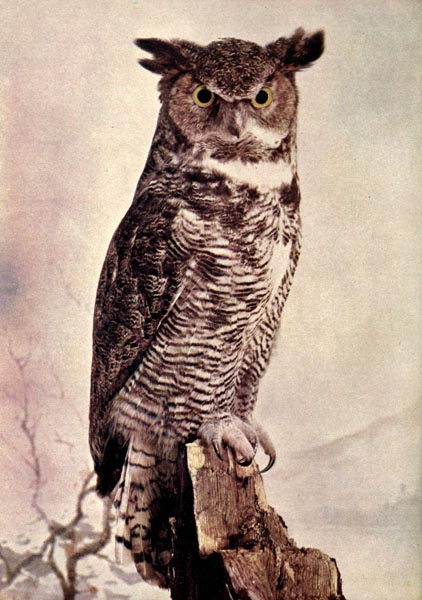
great horned owl.
[Pg 112]
THE OWL.
We know not alway
Who are kings by day,
But the king of the night is the bold brown owl!
I wonder why the folks put
my picture last in the book. It
can’t be because they don’t like
me, for I’m sure I never bother
them. I don’t eat the farmer’s
corn like the crow, and no one
ever saw me quarrel with other
birds.
Maybe it is because I can’t
sing. Well, there are lots of
good people that can’t sing, and
so there are lots of good birds
that can’t sing.
Did you ever see any other
bird sit up as straight as I do?
I couldn’t sit up so straight if I
hadn’t such long, sharp claws to
hold on with.
My home is in the woods.
Here we owls build our nests—most
always in hollow trees.
During the day I stay in the
nest or sit on a limb. I don’t
like day time for the light hurts
my eyes, but when it begins to
grow dark then I like to stir
around. All night long I am
wide awake and fly about getting
food for my little hungry ones.
They sleep most of the day
and it keeps me busy nearly
all night to find them enough to
eat.
I just finished my night’s work
when the man came to take my
picture. It was getting light
and I told him to go to a large
stump on the edge of the woods
and I would sit for my picture.
So here I am. Don’t you think
I look wise? How do you like
my large eyes? If I could smile
at you I would, but my face
always looks sober. I have a
great many cousins and if you
really like my picture, I’ll have
some of them talk to you next
month. I don’t think any of
them have such pretty feathers
though. Just see if they have
when they come.
Well, I must fly back to my
perch in the old elm tree. Good-bye.
THE OWL.
In the hollow tree, in the old gray tower,
The spectral owl doth dwell;
Dull, hated, despised in the sunshine hour,
But at dusk he’s abroad and well!
Not a bird of the forest e’er mates with him;
All mock him outright by day;
But at night, when the woods grow still and dim,
The boldest will shrink away!
O! when the night falls, and roosts the fowl,
Then, then, is the reign of the Horned Owl!
And the owl hath a bride, who is fond and bold,
And loveth the wood’s deep gloom;
And, with eyes like the shine of the moonstone cold,
She awaiteth her ghastly groom.
Not a feather she moves, not a carol she sings,
As she waits in her tree so still,
But when her heart heareth his flapping wings,
She hoots out her welcome shrill!
O! when the moon shines, and dogs do howl,
Then, then, is the joy of the Horned Owl!
Mourn not for the owl, nor his gloomy plight!
The owl hath his share of good—
If a prisoner he be in the broad daylight,
He is lord in the dark greenwood!
Nor lonely the bird, nor his ghastly mate,
They are each unto each a pride;
Thrice fonder, perhaps, since a strange, dark fate
Hath rent them from all beside!
So, when the night falls, and dogs do howl,
Sing, Ho! for the reign of the Horned Owl!
We know not alway
Who are kings by day,
But the King of the Night is the bold Brown Owl!
Bryan W. Procter
(Barry Cornwall.)
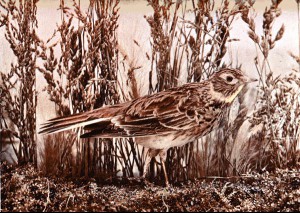
TESTIMONIALS.
Frankfort, Ky., February 3, 1897.
W. J. Black, Vice-President,
Chicago, Ill.
Dear Sir: I have a copy of your magazine entitled “Birds,” and beg to
say that I consider it one of the finest things on the subject that I
have ever seen, and shall be pleased to recommend it to county and city
superintendents of the state.
Very respectfully,
W. J. Davidson,
State Superintendent Public Instruction.
San Francisco, Cal., January 27, 1897.
W. J. Black, Esq.,
Chicago, Ill.
Dear Sir: I am very much obliged for the copy of “Birds” that has just
come to hand. It should be in the hands of every primary and grammar
teacher. I send herewith copy of “List of San Francisco Teachers.”
Very respectfully,
M. Babcock.
Lincoln, Neb., February 9, 1897.
W. J. Black,
Chicago, Ill.
Dear Sir: The first number of your magazine, “Birds,” is upon my desk.
I am highly pleased with it. It will prove a very serviceable
publication—one that strikes out along the right lines. For the purpose
intended, it has, in my opinion, no equal. It is clear, concise, and
admirably illustrated.
Very respectfully,
W. R. Jackson,
State Superintendent Public Instruction.
North Lima, Ohio, February 1, 1897.
Mr. W. E. Watt,
Dear Sir: Sample copy of “Birds” received. All of the family delighted
with it. We wish it unbounded success. It will be an excellent supplement
to “In Birdland” in the Ohio Teachers’ Reading Circle, and I venture Ohio
will be to the front with a good subscription list. I enclose list of
teachers.
Very truly,
C. M. L. Altdoerffer,
Township Superintendent.
Milwaukee, January 30, 1897.
Nature Study Publishing Company,
227 Dearborn Street, Chicago.
Gentlemen: I acknowledge with pleasure the receipt of your publication,
“Birds,” with accompanying circulars. I consider it the best on the subject
in existence. I have submitted the circulars and publication to my teachers,
who have nothing to say but praise in behalf of the monthly.
Julius Torney,
Principal 2nd Dist. Primary School, Milwaukee, Wis.
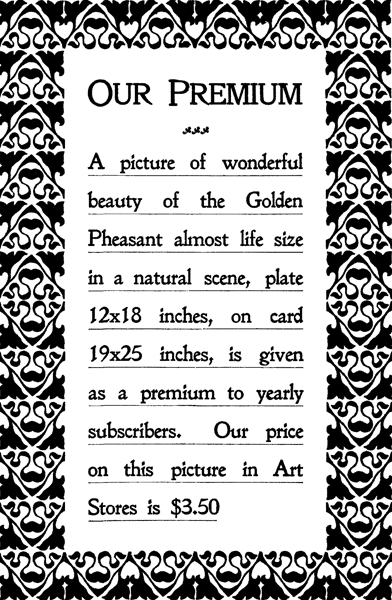
Featured Books

A New Subspecies of Wood Rat (Neotoma mexicana) from Colorado
Robert B. Finley
slightly larger, but cannotbe distinguished by coloration of the pelage.This heretofore undescribed...

A Taxonomic Revision of the Leptodactylid Frog Genus Syrrhophus Cope
John D. Lynch
efinedgenus.With the exception of Taylor (1952), who treated the Costa Ricanspecies, none of these a...

The Most Sentimental Man
Evelyn E. Smith
ns. "Sure you won'tchange your mind and comewith us?"Johnson shook his head.The young man looked ath...

Prologue to an Analogue
Leigh Richmond
orld, would find that the epidemic wascaused by laboratory-developed bacteria, carried in by anAmeri...

Mr. Punch on Tour: The Humour of Travel at Home and Abroad
PUBLISHED BY ARRANGEMENT WITH THE PROPRIETORS OF "PUNCH"THE EDUCATIONAL BOOK CO. LTD.THE PUNCH LIBRA...

Atom Drive
Charles L. Fontenay
the Marsward XVIII."Something like that," agreed Jonner, and his smile broadened. "And Ihave only ab...

Someone Comes to Town, Someone Leaves Town
Cory Doctorow
giving away ebooks displaces the occasional sale, when a downloader reads the book and decides not t...

The Cosmic Computer
H. Beam Piper
y rated amongreaders for his skill and imagination. He has had several novelspublished, including my...
Browse by Category
Join Our Literary Community
Subscribe to our newsletter for exclusive book recommendations, author interviews, and upcoming releases.
Comments on "Birds, Illustrated by Color Photography, Vol. 1, No. 3" :